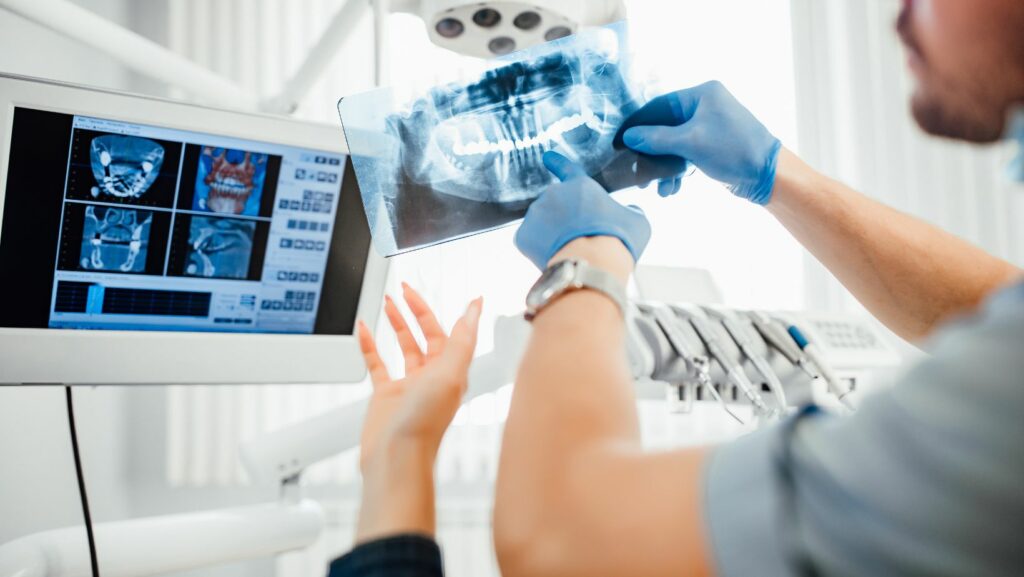
Key Takeaways:
- Dental X-rays allow dentists to detect cavities and bone loss that are not visible during a routine examination, enabling early intervention and orthodontic treatment.
- Different types of dental X-rays, such as bitewing, periapical, panoramic, and cephalometric, each serve specific diagnostic purposes, providing detailed images of various aspects of oral health.
- Dental X-rays are essential for planning procedures, assessing tooth development and alignment, and detecting hidden infections, tumors, and cysts, ensuring comprehensive care and optimal oral health for patients.
During a dental exam, you open wide and say ‘ahh,’ but what can your dentist really see? While a visual examination is crucial, there’s a whole world hidden beneath the surface of your teeth and gums. This is where dental X-rays come in, acting as a dentist’s superpower to peer beyond the visible and uncover potential dental problems.
That said, this article will explore how dental X-rays become your dental hero, revealing hidden cavities, bone loss, and other issues that could threaten your oral health.
Types Of Dental X-Rays
Dental X-rays are crucial for diagnosing and planning treatment for various oral health issues. Here are the main types of dental X-rays and their specific uses:
Bitewing X-rays
When you bite down on those weird wing-shaped plastic things, it allows the X-ray to zero in on the spaces between your upper and lower teeth in each section of your mouth. This gives dental professionals, such as Hunter Dental, the perfect vantage point to spot any sneaky cavities trying to hide where you can’t see them during a regular oral exam.
Periapical X-rays
While they highlight just one or two teeth at a time, they capture the whole undercover story from crown to root tip. It’s your dentist’s chance to investigate any shadiness going on deep below the gumline that you can’t see with the naked eye. Whether it’s an abscess quietly festering, a cyst taking root, or periodontal disease stealthily degrading bone, these X-rays bring it all into focus.
Panoramic X-rays
Panoramic X-rays are like getting an all-access pass to your entire mouth’s inner workings. With just one scan, your dentist gets a complete top-to-bottom, wrap-around view of your teeth, jaws, sinuses – you name it. It’s the best way to spot any potential troublemakers like teeth trying to hide and get impacted, jaw issues brewing, or any developmental curveballs thrown your way.
Cephalometric X-rays
When it comes to straightening smiles with braces or Invisalign, cephalometric X-rays are like an orthodontist’s secret weapon. These specialized scans take a side-view snapshot of your entire face, showing your teeth, jaws, and profile all in one image. With this inside look, your orthodontist can analyze every angle and alignment issue to design a fully customized treatment plan.

The Role Of Dental X-Rays In Uncovering Hidden Oral Issues
Dental X-rays are an essential tool in modern dentistry, aiding significantly in diagnosing hidden oral health issues that are not visible during a routine dental examination. Here’s how they help:
Detecting Cavities
Dental X-rays play a crucial role in detecting cavities that are not visible during a routine dental examination. These images can reveal decay between teeth and under existing fillings, areas that are often difficult to inspect visually. Early detection of cavities through X-rays allows dentists to address the issue before it progresses, preventing further tooth decay, pain, and potential tooth loss.
Identifying Bone Loss
If you’re dealing with gum disease, one of the biggest risks is bone loss in your jaw. Dental X-rays are essential for catching this problem early. These scans give your dentist a crystal clear, zoomed-in view of the bone underneath your teeth and gums. With that level of detail, even the slightest changes in bone density or deterioration can be spotted right away.
Checking for Infections
Infections at the root of a tooth or within the surrounding bone can be difficult to diagnose without the aid of X-rays. These infections may not present immediate symptoms, but if left untreated, they can lead to severe pain and more serious complications. Dental X-rays can reveal these hidden infections, allowing for prompt treatment such as root canals or other interventions.
Evaluating Tooth Development
For kids and teens, those growing years are crucial for their teeth and jaws. That’s why dental X-rays are such an invaluable tool – they give your dentist a sneak peek at what’s going on underneath as those adult teeth start pushing their way in. With those detailed scans, any potential issues can be spotted early, like teeth that might be struggling to erupt properly or coming in misaligned.
Planning for Dental Procedures
Dental X-rays provide a comprehensive map of the mouth’s internal structures, which is invaluable for planning various dental procedures. Whether preparing for implants, braces, extractions, or root canals, detailed X-ray images help dentists and specialists understand the exact positioning and condition of teeth and surrounding bone.

This information is critical for ensuring precision during procedures, reducing the risk of complications, and increasing the likelihood of successful outcomes.
Detecting Tumors and Cysts
Tumors and cysts within the jawbone or surrounding tissues are often asymptomatic in their early stages, making them difficult to detect without imaging. Dental X-rays can reveal the presence of these growths, enabling early diagnosis and prompt treatment. Early detection is vital for improving the prognosis and effectiveness of treatments for these conditions.
Assessing Tooth Position and Alignment
Orthodontists rely heavily on dental X-rays to assess the position and alignment of teeth. These images provide a clear view of how teeth are situated within the jaw and their relationship to each other. This information is critical for designing effective orthodontic treatments such as braces or aligners.
Conclusion
Getting dental X-rays isn’t just some routine box to check off during your visit – they’re crucial for keeping your smile in tip-top shape. These scans give your dentist a behind-the-scenes look at what’s going on underneath your visible teeth and gums. With that inside view, they can catch any potential problems early before they blow up into much bigger issues. Remember, a stitch in time saves nine, and with dental X-rays, a proactive approach to oral health is just a scan away.












